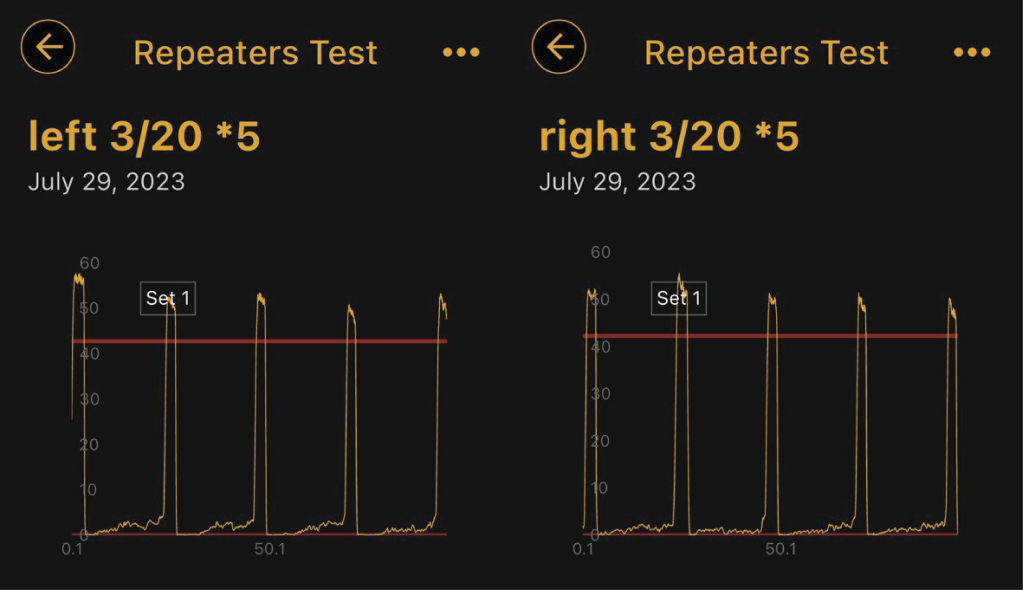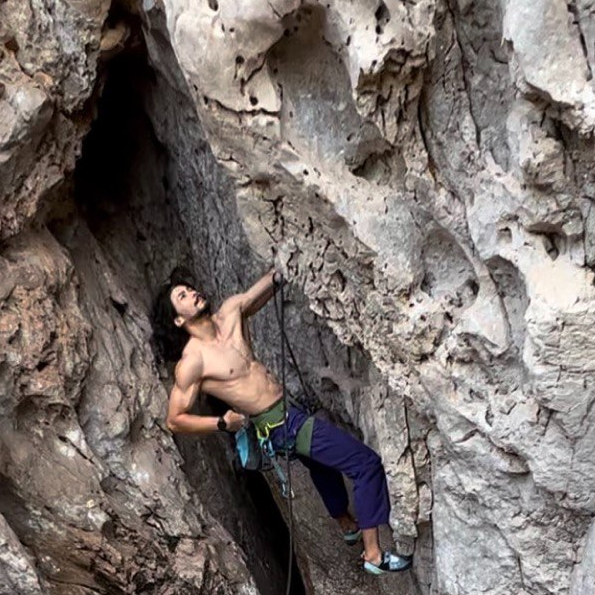Following on from the last post, I’ve been working on improving my finger strength since the end of last December. In the time since, I’ve done two phases with two different methods, both centred around no-hangs with the Tension Block. Going into training again I zoned in on two factors I felt were the most important – Intensity and Adherence. Later on in this post I’ll talk about the first method, using overcoming isometrics.
For the first factor – Intensity – In both protocols I follow what I know about the science of strength training (another thing I’ve been quite into lately) – so exercise repetitions are at a minimum of 80% of my one rep max, pulling 3-5 reps for 3-5 sets, with 3-5 minutes rest between sets. Typically in my work set I’ll do five repetitions, for five sets. Rest is a little over 3 minutes since I am alternating hands and only start my 3-min timer after the second hand is done with the set. Intensity is key for gains in strength and with higher intensity, volume will naturally be low. My weekly target is 10-15 sets per week, also taking into consideration how often I am climbing hard in the gym.
Adherence is probably the most important factor for any training plan. Applying a sub-optimal methodology will probably reap benefits – up to a certain point – as long as adherence and consistency is high. As mentioned previously I think this is what I’ve struggled with the most when attempting a more traditional max-hang regime on a fingerboard over the years. I feel a lot of resistance just thinking about going to the gym to fingerboard. If I do make it there, I then have the distraction of just climbing to contend with, which I tend to succumb to. Having the no-hang setup at home has removed a lot of that limbic friction and distraction. In part I believe the hours I’ve spent rehabbing my Achilles’ tendon rupture in my balcony not only ingrained discipline in me but also has my brain associating the space as my training zone.

On to the first method. Conceptually it is quite simple – work a muscle or muscle group by contracting it as hard as voluntarily possible – Maximum Voluntary Contraction (MVC) or overcoming isometics. I don’t know how long this has been around but I was introduced to the idea (specifically for finger strength) by Tyler Nelson of C4HP (@c4hp). The appeal was minimal equipment – a portable hangboard, a sling and a place to anchor the setup to. At that point in time I didn’t have enough weight plates to do the Yves Arm-Lifting Method – which just so happens to be the second phase, coming in the next post – so I bought into the idea and started training this way.

I did end up investing in a load cell early in the phase – The Tindeq – which is where the data in this post comes from. It’s probably not a necessary part of the setup – as long as the protocol is done with the intention of MVC for each repetition I’d hazard a guess that strength gains will be made and when measured the numbers will show an increase. Initially I wanted to have it just to track my progress, taking measurements of my peak load at regular (ok, not so regular as my data will show) intervals through the phase, but the app comes with features to set up and record different training protocols.

A training set looks like this – 3 second MVC, 20 second recovery for 5 repetitions (photo below). The upper red line is the indicator for 80% of max. After each set is a minimum of 3 minutes rest. While I try for 5 sets on most days, if the app is showing that I’m falling below the line on consecutive reps I will stop the session and call it a day. I believe it indicates that I was carrying fatigue into the session and pushing on with sub-optimal sets is not productive. Compounding the fatigue also probably increases the chance of injury, so the Tindeq has been useful for me as an indicator of sorts, that my finger flexors are too tired for any more training to be productive.

Below is a chart of the data I’ve recorded from Dec ‘22 till most recently on 31st July ‘23. Some notes – I did this method of training consistently from Dec ’22 till April ‘23, took a break from any finger training till the start of June, which was when I started the Yves Arm-Lifting Method since I had the weights. Progress is not linear but I also take into account that on some testing days my fingers are fatigued or that I had to rush and didn’t have a proper warm up for recruitment. On testing days I take peak load readings three times for each hand with a minimum of three minutes rest, then I get the averages.

Some other notes here.
- The first two measurements are inaccurate as I was still figuring out a setup that best had me isolating the finger flexors and not pulling with the whole arm/shoulder.
- The third point I noted that I my fingers felt a little tweaky from a climbing session the day before.
- The 8th of May was just a random test, having not done any training for a few weeks.
- The latest two data points are the results of the second training method I’ve been doing.
As I type this and look over the data again I must say that it feels quite motivating, like, I want to drop everything and have a training session right now. The numbers seem to be translating well where it actually matters – on the wall. I am a lot more keen and confident on crimpy lines, I feel good on them. On a slightly different yardstick – just yesterday I finally managed a one arm hang on the 20mm edge, felt good, then did the smallest edge of the Beastmaker 1000 for a solid second!
Okay time to conclude this post. I think the MVC/overcoming isometrics method of training fingers was productive for me. While I am in a different phase with a different method, I plan on going back to this for the next round. The Yves Arm-Lifting Method feels more similar to max hangs, where passive tension becomes a factor and it shows – I can lift more than I can pull. I’ll talk about both things more in the next post. Here is a link to an article by Tyler Nelson about finger strength training.

Leave a comment